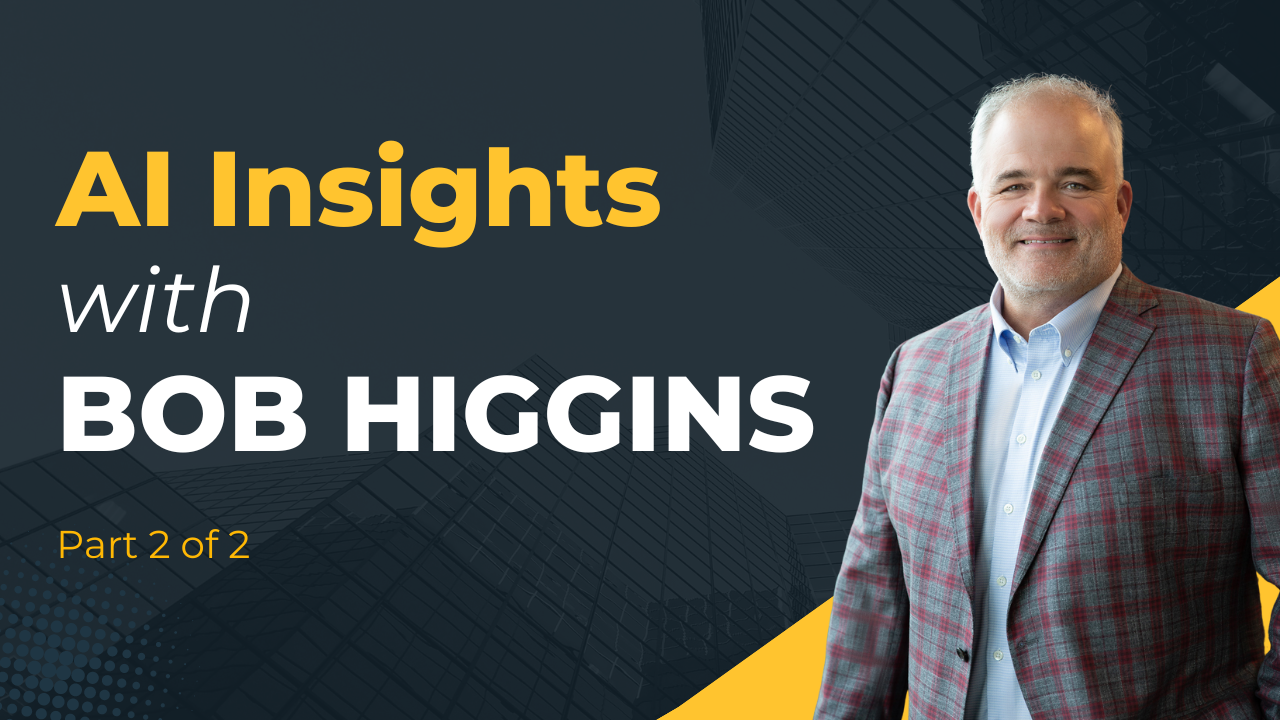AI Insights with Bob Higgins

This is a continuation of an article in which Barge Design CEO Bob Higgins offers responses to frequent questions he receives from other leaders regarding implementing AI. Read the first installment here.
Question: So many leaders are super-focused on accomplishment; they are driven to make progress in many areas of their organization. So naturally I hear questions similar to “What can I do next week to advance AI in my firm?”.
Answer: Let’s keep it really practical. I’ve got three ideas.
First, if you are in the preliminary stage of introducing AI, here are several recommendations.
- Create a cross-functional advisory team to begin your AI journey
- Establish an AI vision for your firm that complements its business goals
- Identify a pressing problem to solve or an opportunity to elevate
- Create an initial AI hypothesis for that problem or opportunity
Second, if you have some AI initiatives under your belt, but perhaps they are ad hoc actions by some employees, here are a few more suggestions.
- Examine your firm’s readiness to move forward; conduct an AI internal assessment of data, technology, structure, people, processes, etc.
- Identify the unique AI skillsets and passions already active in the firm; harness their enthusiasm for planning and employee adoption
- Create AI guidelines and governance to focus on compliance, acceptable use, and best practices
And finally, another idea is to consider a program that Thrivence just rolled out. We want to give firms the opportunity to integrate AI in a meaningful way. It’s called “AI Advantage”.
- We’re selecting only 10 firms; we’ll focus just on a few and provide quick results
- We’d like to have firms of all sizes represented (small, medium, and large)
- Not only is the program highly discounted, there are other free ways we are going to help the firms and their leaders
- You can find out more information here
Looking to level up your understanding and practice of AI? Gain access to our new course today – Leading AI: A Masterclass for AEC Leaders
Question: Not all leaders are at the starting line; some have run a few laps and gotten a feel of how AI can benefit their firm. In these cases, the question is “We have had some success with small AI use cases. How do we best scale AI to get more value?”.
Answer: First of all, congratulations for taking some first steps. It’s pretty easy to build on success, so let’s generate momentum. Ideas to capitalize on those successes include:
- Celebrate them. This should top your list. Publicly highlight key team members and the positive outcomes generated. Encourage fellow colleagues to emulate.
- Learn from them; conduct regular pre- and post-mortems to optimize scalability. A diligent emphasis on getting better will spur ideas for even more AI value.
- Increase scope and complexity. Set the bar higher for each new use case. Challenge teams to forge new ground across all functional areas of the firm.
- Seek external case studies of successful AI applications you can replicate. Learning from similar firms (and even organizations in other industries) can introduce ideas not yet tried in your company.
- Finalize success metrics; establish clear, tangible progress measures. Having specific, energizing, and timely goals help keep focus and drive results.
- Prioritize continuous learning; AI evolution is rapidly changing. Build or contract AI workshops and training at regular intervals. They signal AI’s importance to the firm.
- Consider an AI implementation Playbook to codify planning and execution. Standardizing resources, budgets, tools, and other assets help scale AI in multiple ways.
Question: This next question keeps popping up in every circle, I suspect. Because the AI landscape is so volatile, we tend to react to continuous change. Leaders typically want to prepare, so the question often is “What’s coming next in AI? How can we best prepare?”.
Answer: It seems as if there is some new AI revelation or discovery every week. It’s difficult to keep up with so much evolution. I always tell leaders, chase your challenges and opportunities first, not the technology. As leaders if we do this it keeps us focused on our own strategies instead of staying on the bleeding edge of technology. With that said I talk often with Thrivence about this…what are we seeing in the marketplace? What do we need to be paying attention to?
Though it’s difficult to pin down any definitive predictions, there are some trends we can point to that can inform a pretty safe bet of direction this year. In no particular order (and definitely not a complete list):
- AI regulations will be front and center this year. Protection guidelines, risk mitigations, jurisdictions, for example. They continue to evolve slowly, mainly because we don’t fully know implications. We see every level of government weighing in: state, national, and global. The legal complexity is mind-bending, and enforcement considerations are all over the map. So we have to remain informed and adaptable as regulations evolve.
- Our loss of privacy will continue, and thus privacy concerns will escalate. As increasingly powerful AI algorithms more easily assess massive amounts of personal data on us, systems will likely know more about us that we do about ourselves. For many people, that’s untenable.
- Large Language Models will continue to evolve at breathtaking speed. Just look at the numerous iterations in the last six months. There are thousands of them now. And we see them not only becoming more expansive, but also more specialized by use and content.
- AI will become fully multi-modal, meaning incorporating all the senses and input types: images, text, video, audio, etc. Think about AI moving toward mimicking the human ability to process diverse sensory information. The examples are almost endless: how about taking a picture of the inside of your fridge and asking AI to suggest a recipe based on the ingredients in the photo? That’s incredible.
- This year we’ll see a significant shift from AI being reactive to it being proactive. So moving from us providing AI inputs (like in a chat) and AI responding, to AI independently and actively doing things on our behalf. It’s called Agentic AI. Think about AI actively managing your investment portfolio in real-time, choosing a restaurant knowing your tastes and booking it based on your Outlook calendar, finding a flight and reserving it. Your Personal Assistant!
- Hallucinations (errors) will decrease. As you’ve experienced, AI models can produce plausible-sounding but incorrect responses, and that’s been a huge barrier to adoption. A new capability has emerged called Retrieval-Augmented Generation (RAG) that blends traditional text generation with information retrieval to enhance accuracy and relevance. In other words, it helps LLMs to access external information, bypassing the need to store dated content within the model. The key benefit is up-to-date factual knowledge.
- There’s also a shift from Enterprise AI to Individual AI. Think about how many times recently you’ve seen specific products or services tout the integration of AI functionality. From building a presentation deck to planning a project, AI is infiltrating almost all worker productivity tools. Industry experts call this Shadow AI or “Bring Your Own AI”. There will be widespread AI use throughout your firm that you know nothing about. Sure, it engenders an independent, innovative spirit … but it also carries some risk around security, compliance, and privacy.
If you would like further guidance on any of the learnings or ways to increase AI adoption within your organization, please do not hesitate to contact us at info@thrivence.com.


Gary McClure is a senior consultant at Thrivence, a consulting firm specializing in strategy, leader development, organizational performance, and technology. For more than 15 years, Gary has led organizational transformation initiatives and taught leaders how to navigate successful change. He can be reached at gary.mcclure@thrivence.com.



